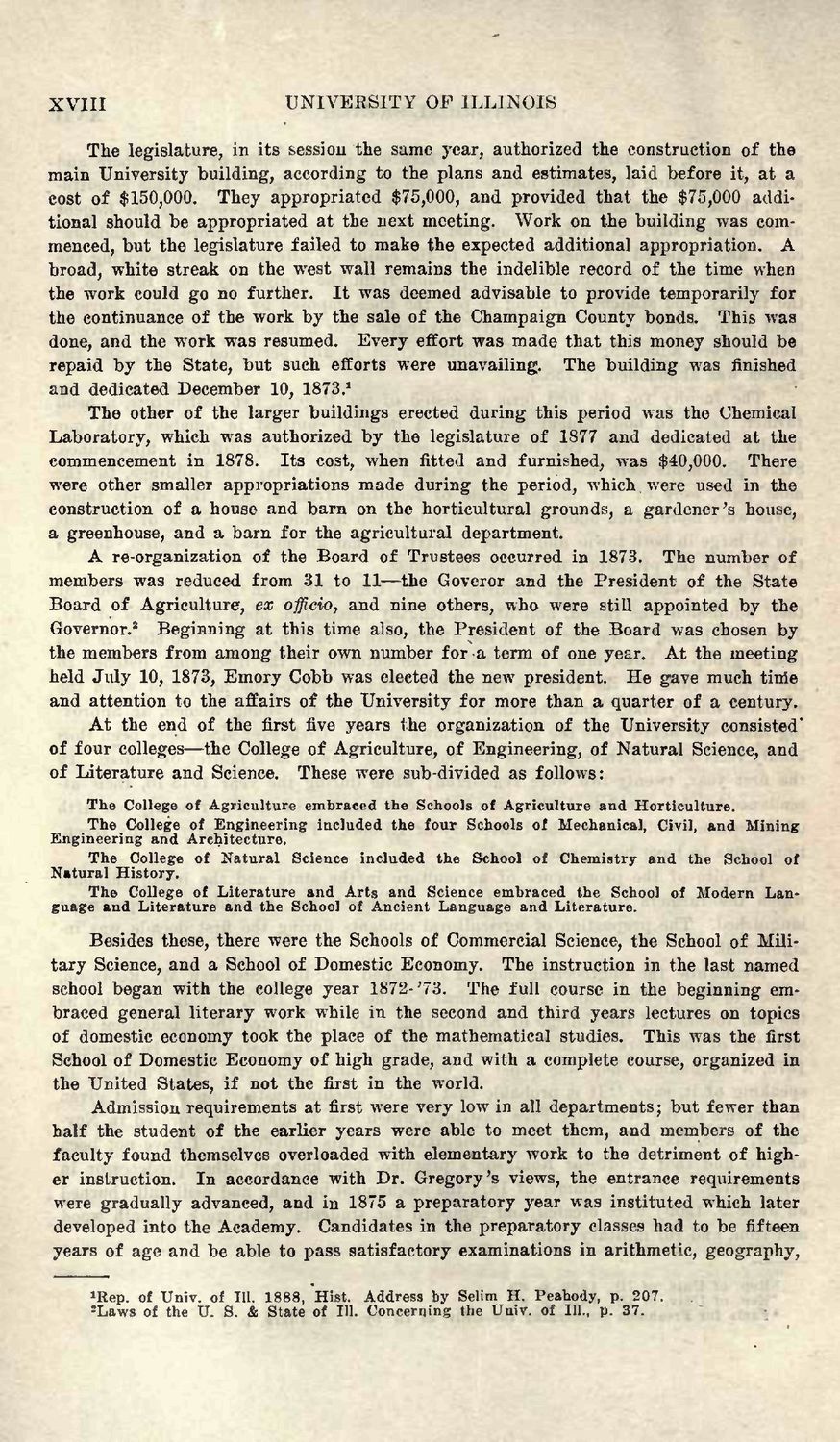| |
| |
Caption: Book - Early History of University (1916)
This is a reduced-resolution page image for fast online browsing.

EXTRACTED TEXT FROM PAGE:
XVIII U N I V E E S I T Y OP I L L I N O I S The legislature, in its session the same year, authorized the construction of the main University building, according to the plans and estimates, laid before it, at a cost of $150,000. They appropriated $75,000, and provided that the $75,000 additional should be appropriated at the next meeting. Work on the building was commenced, but the legislature failed to make the expected additional appropriation. A broad, white streak on the west wall remains the indelible record of the time when the work could go no further. I t was deemed advisable to provide temporarily for the continuance of the work by the sale of the Champaign County bonds. This was done, and the work was resumed. Every effort was made that this money should be repaid by the State, but such efforts were unavailing. The building was finished and dedicated December 10, 1873.1 The other of the larger buildings erected during this period was the Chemical Laboratory, which was authorized by the legislature of 1877 and dedicated at the commencement in 1878. I t s cost, when fitted and furnished, was $40,000. There were other smaller appropriations made during the period, which, were used in the construction of a house and barn on the horticultural grounds, a gardener's house, a greenhouse, and a barn for the agricultural department. A re-organization of the Board of Trustees occurred in 1873. The number of members was reduced from 31 to 11—the Goveror and the President of the State Board of Agriculture, ex officio, and nine others, who were still appointed by the Governor.2 Beginning at this time also, the President of the Board was chosen by the members from among their own number for -a term of one year. At the meeting held July 10, 1873, Emory Cobb was elected the new president. He gave much tinie and attention to the affairs of the University for more than a quarter of a century. At the end of the first five years the organization of the University consisted' of four colleges—the College of Agriculture, of Engineering, of Natural Science, and of Literature and Science. These were sub-divided as follows: The College of Agriculture embraced the Schools of Agriculture and Horticulture. The College of Engineering included the four Schools of Mechanical, Civil, and Mining Engineering and Architecture. The College of Natural Science included the School of Chemistry and the School of Natural History. The College of Literature and Arts and Science embraced the School of Modern Language and Literature and the School of Ancient Language and Literature. Besides these, there were the Schools of Commercial Science, the School of Military Science, and a School of Domestic Economy. The instruction in the last named school began with the college year 1872- '73. The full course in the beginning embraced general literary work while in the second and third years lectures on topics of domestic economy took the place of the mathematical studies. This was the first School of Domestic Economy of high grade, and with a complete course, organized in the United States, if not the first in the world. Admission requirements at first were very low in all departments; but fewer than half the student of the earlier years were able to meet them, and members of the faculty found themselves overloaded with elementary work to the detriment of higher instruction. In accordance with Dr. Gregory's views, the entrance requirements were gradually advanced, and in 1875 a preparatory year was instituted which later developed into the Academy. Candidates in the preparatory classes had to be fifteen years of age and be able to pass satisfactory examinations in arithmetic, geography, >Rep. of Univ. of III. 1888, Hist. Address by Selim H. Peahody, p. 207. =Laws of the U. S. & State of 111. Concerning the Univ. of 111., p. 37.
| |